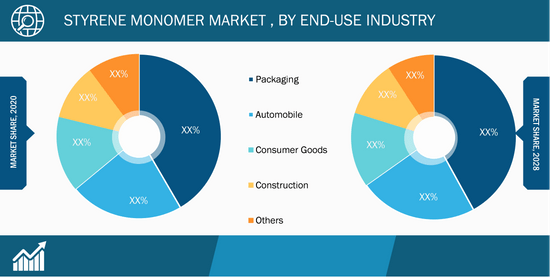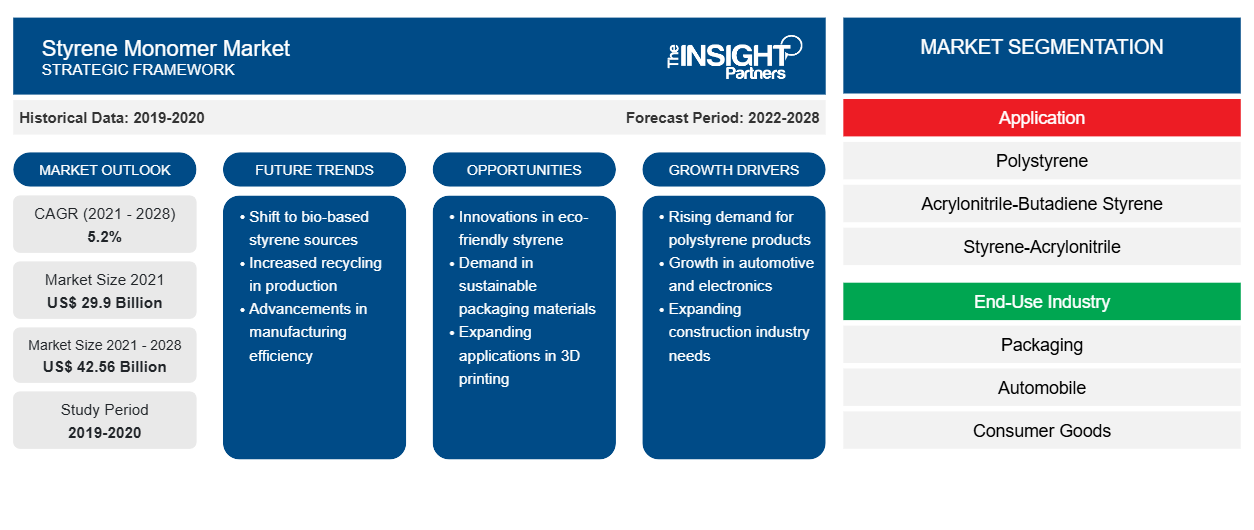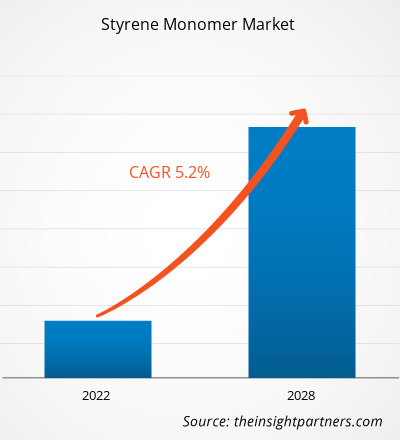Der Markt für Styrolmonomere wurde im Jahr 2021 auf 29.904,30 Millionen US-Dollar geschätzt und soll bis 2028 42.558,55 Millionen US-Dollar erreichen; von 2021 bis 2028 wird ein durchschnittliches jährliches Wachstum von 5,2 % erwartet.
Styrolmonomer wird als Baustein zur Herstellung einer Vielzahl von Kunststoff- und Gummiprodukten verwendet. Styrolmonomer wird hauptsächlich zur Herstellung von Polystyrol (PS) verwendet. Polystyrol wird in verschiedenen Anwendungen eingesetzt, darunter Verpackungen, Unterhaltungselektronik, Spielzeug und Freizeitgeräte. Styrolmonomer wird auch zur Herstellung von expandiertem Polystyrol (EPS), Styrol-Acrylnitril (SAN), Acrylnitril-Butadien-Styrol (ABS), ungesättigten Polyesterharzen (UPR), Styrol-Butadien-Kautschuk (SBR) und Styrol-Butadien-Latex (SBL) verwendet.
Im Jahr 2020 hatte der asiatisch-pazifische Raum den größten Umsatzanteil am globalen Styrolmonomermarkt . Im asiatisch-pazifischen Raum treibt die zunehmende Urbanisierung die Nachfrage nach Styrolmonomer an. Die Bauindustrie verwendet in großem Umfang Produkte auf Styrolbasis für Baumaterialien. Darüber hinaus wird Styrolmonomer häufig zur Herstellung von Farben verwendet. Darüber hinaus wird erwartet, dass die zunehmende strategische Partnerschaft und die Joint Ventures zwischen den Marktteilnehmern den Markt im asiatisch-pazifischen Raum positiv beeinflussen werden.
Passen Sie diesen Bericht Ihren Anforderungen an
Sie erhalten kostenlose Anpassungen an jedem Bericht, einschließlich Teilen dieses Berichts oder einer Analyse auf Länderebene, eines Excel-Datenpakets sowie tolle Angebote und Rabatte für Start-ups und Universitäten.
- Holen Sie sich die wichtigsten Markttrends aus diesem Bericht.Dieses KOSTENLOSE Beispiel umfasst eine Datenanalyse von Markttrends bis hin zu Schätzungen und Prognosen.
Auswirkungen der COVID-19-Pandemie auf den Styrolmonomermarkt
Die COVID-19-Pandemie hat den Status des Chemie- und Materialsektors drastisch verändert und sich negativ auf das Wachstum des Styrolmonomermarktes ausgewirkt. Der deutliche Rückgang des Wachstums mehrerer Industriezweige hat sich auf die Nachfrage nach Styrolmonomeren auf dem Weltmarkt ausgewirkt. In verschiedenen Branchen kam es aufgrund der COVID-19-Pandemie zu Lieferkettenunterbrechungen. Die Nachfrage nach Styrolmonomeren wurde durch die vollständige Einstellung der Bautätigkeiten negativ beeinflusst. Die Pandemie hat auch zu Preisschwankungen bei Styrolmonomeren geführt. Da die Volkswirtschaften jedoch planen, ihre Aktivitäten wieder anzukurbeln, wird erwartet, dass die Nachfrage nach Styrolmonomeren weltweit steigen wird. Die zuvor verschobenen Bauprojekte können nun wieder aufgenommen werden, was den Akteuren auf dem Styrolmonomermarkt eine weitere Gelegenheit bietet, zur Normalität zurückzukehren.
Aufschlüsselung des globalen Styrolmonomermarktes – nach Regionen
- Dieses KOSTENLOSE Beispiel umfasst eine Datenanalyse von Markttrends bis hin zu Schätzungen und Prognosen.
Markteinblicke
Steigende Nachfrage aus verschiedenen Endverbrauchsbranchen
Styrolmonomer wird hauptsächlich zur Herstellung von Polystyrol (PS) verwendet, das in verschiedenen Alltagsprodukten zum Einsatz kommt. Die steigende Nachfrage nach Polystyrol für verschiedene Anwendungen wie Verpackungen und Unterhaltungselektronik führt zu einer Nachfrage nach Styrolmonomeren. Expandierbare Polystyrolperlen werden hauptsächlich in der Dämm- und Verpackungsindustrie verwendet, während expandiertes Polystyrol das Design und die strukturelle Integrität von Gebäuden verbessern kann. Die steigende Nachfrage nach diesen Materialien aus verschiedenen Endverbrauchsindustrien treibt diesen Markt erheblich an.
Einblicke in die Endverbraucherbranche
Basierend auf der Endverbrauchsbranche wurde der globale Markt für Styrolmonomere in Verpackungen, Automobile, Konsumgüter, Bauwesen und andere unterteilt. Das Verpackungssegment hielt im Jahr 2020 den größten Anteil am globalen Markt für Styrolmonomere. Festes Polystyrol findet Anwendung in Verpackungsprodukten und starren Lebensmittelbehältern. Polystyrolschaum wird in leichten Schutzverpackungen und Lebensmittelbehältern verwendet.
Styrolmonomer-Markt nach Endverbrauchsbranche – 2020 und 2028


- Dieses KOSTENLOSE Beispiel umfasst eine Datenanalyse von Markttrends bis hin zu Schätzungen und Prognosen.
Zu den wichtigsten Akteuren auf dem globalen Markt für Styrolmonomere zählen Americas Styrenics LLC (AmSty); Asahi Kasei Corporation; BASF SE; Idemitsu Kosan Co., Ltd.; INEOS Styrolution Group GmbH; LG Chem; LOTTE Chemical CORPORATION; LyondellBasell Industries Holdings BV; Trinseo; und Westlake Chemical Corporation. Die Akteure auf dem Markt konzentrieren sich stark auf die Entwicklung qualitativ hochwertiger und innovativer Produktangebote, um die Anforderungen der Kunden zu erfüllen.
Bericht-Spotlights
- Fortschrittliche Branchentrends auf dem Styrolmonomermarkt helfen den Akteuren bei der Entwicklung wirksamer langfristiger Strategien
- In Industrie- und Entwicklungsländern angewandte Strategien für Unternehmenswachstum
- Quantitative Analyse des Styrolmonomermarktes von 2019 bis 2028
- Schätzung der weltweiten Nachfrage nach Styrolmonomer
- Porters Fünf-Kräfte-Analyse zur Veranschaulichung der Wirksamkeit der in der Branche tätigen Käufer und Lieferanten
- Aktuelle Entwicklungen zum Verständnis des wettbewerbsorientierten Marktszenarios
- Markttrends und -aussichten sowie Faktoren, die das Wachstum des Styrolmonomermarktes vorantreiben und bremsen
- Unterstützung im Entscheidungsprozess durch Aufzeigen von Marktstrategien, die das kommerzielle Interesse untermauern und zum Marktwachstum führen
- Die Größe des Styrolmonomermarktes an verschiedenen Knotenpunkten
- Detaillierte Übersicht und Segmentierung des Marktes sowie der Dynamik der Styrolmonomerindustrie
- Größe des Styrolmonomermarktes in verschiedenen Regionen mit vielversprechenden Wachstumschancen
Globaler Markt für Styrolmonomer
Nach Anwendung
- Polystyrol
- Acrylnitril-Butadien-Styrol (ABS)
- Styrol-Acrylnitril (SAN)
- SB Latex und Gummi
- Sonstiges
Endverbrauchsindustrie
- Verpackung
- Automobil
- Konsumgüter
- Konstruktion
- Sonstiges
Firmenprofile
- Americas Styrenics LLC (AmSty)
- Asahi Kasei Corporation
- BASF SE
- Idemitsu Kosan Co., Ltd.
- INEOS Styrolution Group GmbH
- LG Chem
- LOTTE Chemical CORPORATION
- LyondellBasell Industries Holdings BV
- Trinseo
- Westlake Chemical Corporation
Umfang des Styrolmonomer-Berichts
| Berichtsattribut | Details |
|---|---|
| Marktgröße im Jahr 2021 | 29,9 Milliarden US-Dollar |
| Marktgröße bis 2028 | 42,56 Milliarden US-Dollar |
| Globale CAGR (2021 - 2028) | 5,2 % |
| Historische Daten | 2019-2020 |
| Prognosezeitraum | 2022–2028 |
| Abgedeckte Segmente | Nach Anwendung
|
| Abgedeckte Regionen und Länder | Nordamerika
|
| Marktführer und wichtige Unternehmensprofile |
|
- Historische Analyse (2 Jahre), Basisjahr, Prognose (7 Jahre) mit CAGR
- PEST- und SWOT-Analyse
- Marktgröße Wert/Volumen – Global, Regional, Land
- Branche und Wettbewerbsumfeld
- Excel-Datensatz



Report Coverage
Revenue forecast, Company Analysis, Industry landscape, Growth factors, and Trends

Segment Covered
This text is related
to segments covered.

Regional Scope
North America, Europe, Asia Pacific, Middle East & Africa, South & Central America

Country Scope
This text is related
to country scope.
Häufig gestellte Fragen
The major players operating in the global styrene monomer market are Americas Styrenics LLC (AmSty), Asahi Kasei Corporation, BASF SE, Idemitsu Kosan Co.,Ltd., INEOS Styrolution Group GmbH, LG Chem, LOTTE Chemical CORPORATION, LyondellBasell Industries Holdings B.V., Trinseo, Westlake Chemical Corporation, among others.
In 2021, Asia Pacific held the largest share of the global styrene monomer market. The food industry is one of the major end-users of the styrene monomer as it is extensively utilized in food packaging. Moreover, in the Asia Pacific region, growing construction work is expected to accelerate the demand for styrene monomers.
The polystyrene segment held the largest share of the global styrene monomer market in 2021. Styrene is mainly used in the production of polystyrene, which is a major material used in applications such as packaging, consumer electronics, toys, recreational equipment, and refrigerator door liners.
Ans. The packaging segment held the largest share of the styrene monomer market in 2021. Styrene monomers are extensively utilized in food packaging. Polystyrene foam is used in lightweight protective packaging and foodservice containers.
The Acrylonitrile-Butadiene Styrene (ABS) segment is the fastest growing segment in the global styrene monomer market during the forecasted period. Various properties of acrylonitrile-butadiene styrene plastic make it a suitable material for applications such as automotive, sports equipment, electrical appliances, and toys.
The automobile segment is the fastest growing segment in the global styrene monomer market during the forecasted period. Acrylonitrile-butadiene styrene (as a thermoplastic resin) and styrene-acrylonitrile are used in automotive applications.
Trends and growth analysis reports related to Chemicals and Materials : READ MORE..
The List of Companies - Styrene Monomer Market
- Americas Styrenics LLC (AmSty)
- Asahi Kasei Corporation
- BASF SE
- Idemitsu Kosan Co.,Ltd
- INEOS Styrolution Group GmbH
- LG Chem
- LOTTE Chemical CORPORATION
- LyondellBasell Industries Holdings B.V
- Trinseo
- Westlake Chemical Corporation
The Insight Partners performs research in 4 major stages: Data Collection & Secondary Research, Primary Research, Data Analysis and Data Triangulation & Final Review.
- Data Collection and Secondary Research:
As a market research and consulting firm operating from a decade, we have published and advised several client across the globe. First step for any study will start with an assessment of currently available data and insights from existing reports. Further, historical and current market information is collected from Investor Presentations, Annual Reports, SEC Filings, etc., and other information related to company’s performance and market positioning are gathered from Paid Databases (Factiva, Hoovers, and Reuters) and various other publications available in public domain.
Several associations trade associates, technical forums, institutes, societies and organization are accessed to gain technical as well as market related insights through their publications such as research papers, blogs and press releases related to the studies are referred to get cues about the market. Further, white papers, journals, magazines, and other news articles published in last 3 years are scrutinized and analyzed to understand the current market trends.
- Primary Research:
The primarily interview analysis comprise of data obtained from industry participants interview and answers to survey questions gathered by in-house primary team.
For primary research, interviews are conducted with industry experts/CEOs/Marketing Managers/VPs/Subject Matter Experts from both demand and supply side to get a 360-degree view of the market. The primary team conducts several interviews based on the complexity of the markets to understand the various market trends and dynamics which makes research more credible and precise.
A typical research interview fulfils the following functions:
- Provides first-hand information on the market size, market trends, growth trends, competitive landscape, and outlook
- Validates and strengthens in-house secondary research findings
- Develops the analysis team’s expertise and market understanding
Primary research involves email interactions and telephone interviews for each market, category, segment, and sub-segment across geographies. The participants who typically take part in such a process include, but are not limited to:
- Industry participants: VPs, business development managers, market intelligence managers and national sales managers
- Outside experts: Valuation experts, research analysts and key opinion leaders specializing in the electronics and semiconductor industry.
Below is the breakup of our primary respondents by company, designation, and region:

Once we receive the confirmation from primary research sources or primary respondents, we finalize the base year market estimation and forecast the data as per the macroeconomic and microeconomic factors assessed during data collection.
- Data Analysis:
Once data is validated through both secondary as well as primary respondents, we finalize the market estimations by hypothesis formulation and factor analysis at regional and country level.
- Macro-Economic Factor Analysis:
We analyse macroeconomic indicators such the gross domestic product (GDP), increase in the demand for goods and services across industries, technological advancement, regional economic growth, governmental policies, the influence of COVID-19, PEST analysis, and other aspects. This analysis aids in setting benchmarks for various nations/regions and approximating market splits. Additionally, the general trend of the aforementioned components aid in determining the market's development possibilities.
- Country Level Data:
Various factors that are especially aligned to the country are taken into account to determine the market size for a certain area and country, including the presence of vendors, such as headquarters and offices, the country's GDP, demand patterns, and industry growth. To comprehend the market dynamics for the nation, a number of growth variables, inhibitors, application areas, and current market trends are researched. The aforementioned elements aid in determining the country's overall market's growth potential.
- Company Profile:
The “Table of Contents” is formulated by listing and analyzing more than 25 - 30 companies operating in the market ecosystem across geographies. However, we profile only 10 companies as a standard practice in our syndicate reports. These 10 companies comprise leading, emerging, and regional players. Nonetheless, our analysis is not restricted to the 10 listed companies, we also analyze other companies present in the market to develop a holistic view and understand the prevailing trends. The “Company Profiles” section in the report covers key facts, business description, products & services, financial information, SWOT analysis, and key developments. The financial information presented is extracted from the annual reports and official documents of the publicly listed companies. Upon collecting the information for the sections of respective companies, we verify them via various primary sources and then compile the data in respective company profiles. The company level information helps us in deriving the base number as well as in forecasting the market size.
- Developing Base Number:
Aggregation of sales statistics (2020-2022) and macro-economic factor, and other secondary and primary research insights are utilized to arrive at base number and related market shares for 2022. The data gaps are identified in this step and relevant market data is analyzed, collected from paid primary interviews or databases. On finalizing the base year market size, forecasts are developed on the basis of macro-economic, industry and market growth factors and company level analysis.
- Data Triangulation and Final Review:
The market findings and base year market size calculations are validated from supply as well as demand side. Demand side validations are based on macro-economic factor analysis and benchmarks for respective regions and countries. In case of supply side validations, revenues of major companies are estimated (in case not available) based on industry benchmark, approximate number of employees, product portfolio, and primary interviews revenues are gathered. Further revenue from target product/service segment is assessed to avoid overshooting of market statistics. In case of heavy deviations between supply and demand side values, all thes steps are repeated to achieve synchronization.
We follow an iterative model, wherein we share our research findings with Subject Matter Experts (SME’s) and Key Opinion Leaders (KOLs) until consensus view of the market is not formulated – this model negates any drastic deviation in the opinions of experts. Only validated and universally acceptable research findings are quoted in our reports.
We have important check points that we use to validate our research findings – which we call – data triangulation, where we validate the information, we generate from secondary sources with primary interviews and then we re-validate with our internal data bases and Subject matter experts. This comprehensive model enables us to deliver high quality, reliable data in shortest possible time.


 Holen Sie sich ein kostenloses Muster für diesen Bericht
Holen Sie sich ein kostenloses Muster für diesen Bericht